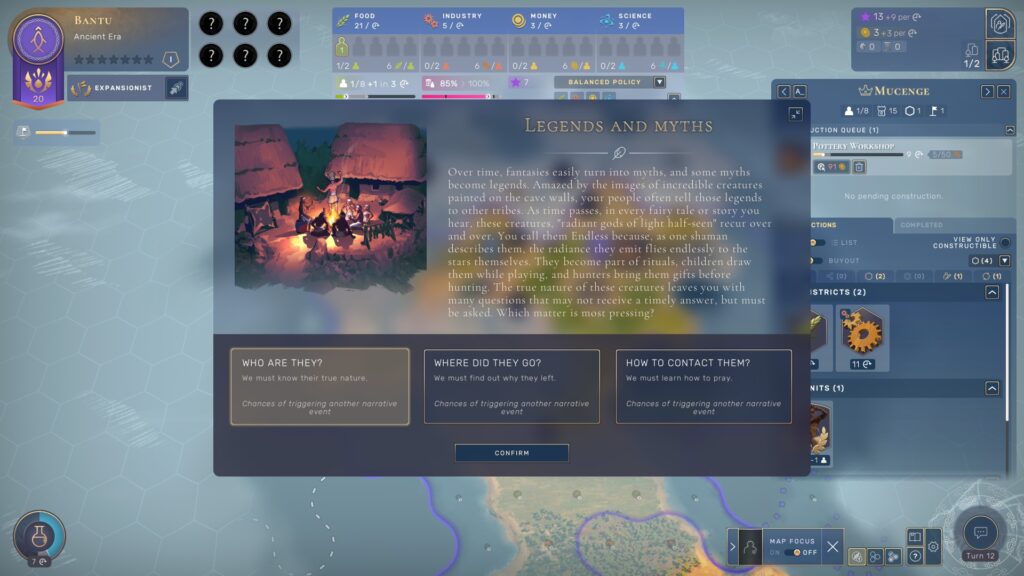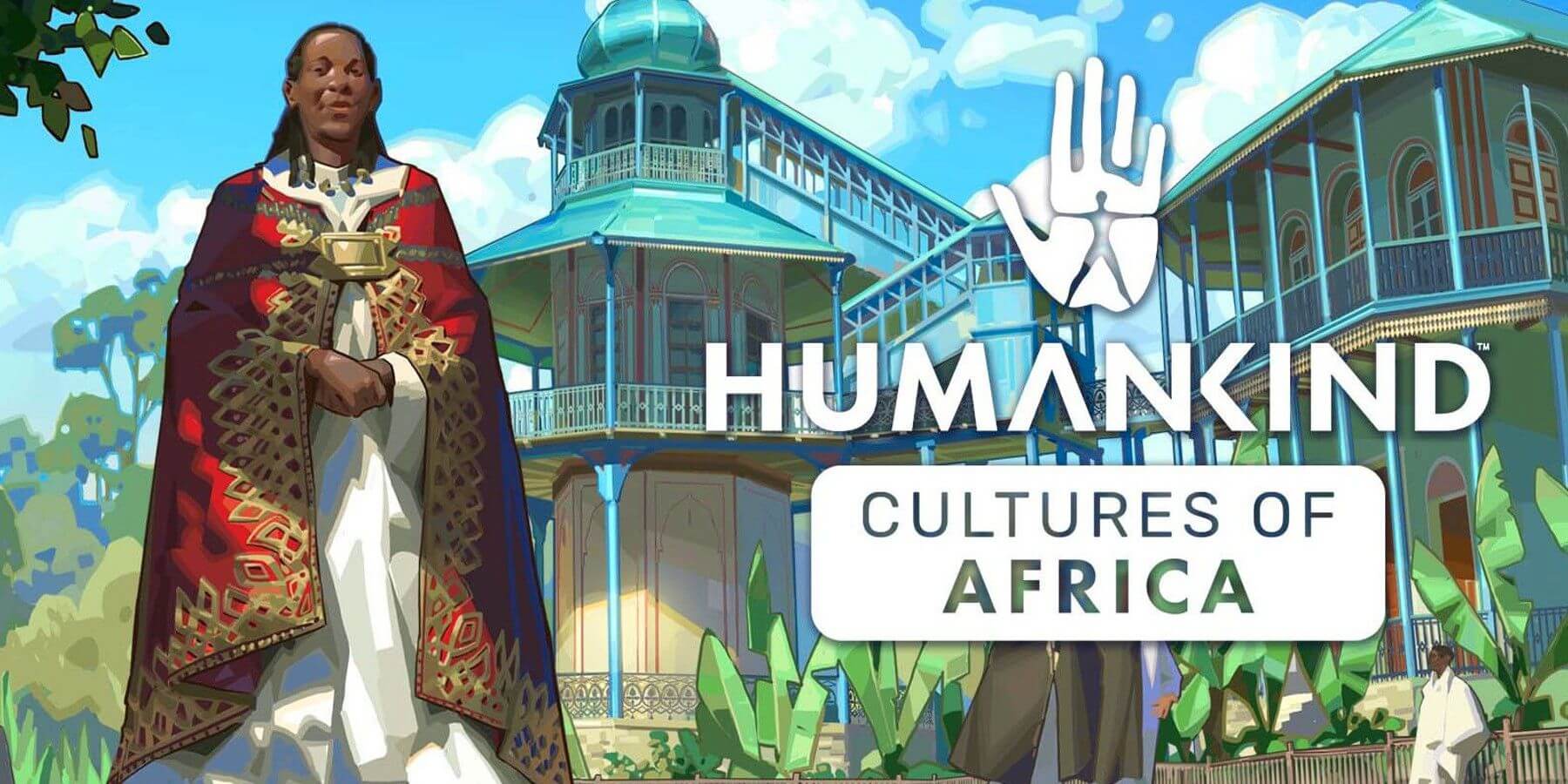Amplitude Studios held its anniversary celebration this week. Being the first Amplified event since the launch of their much-anticipated Humankind, it was inevitable that the focus would be on that game. Fans were treated to Humankind’s first DLC, Cultures of Africa, along with some other juicy content. Today we’ll be taking a look at the DLC itself, as well as touching on some of the free features added with Humankind‘s January 2022 update.
What’s In The DLC?

As you might expect from the name, Cultures of Africa introduces six new playable cultures – one for each era – from across the long history of Africa. It also adds new Natural and Cultural Wonders as well as narrative events and more Independent Peoples to trade with, assimilate, or conquer. Among the new Cultural Wonders, the Great Mosque of Djenne stands out in particular.
In addition to generating a large amount of Faith like the other religion-themed Wonders, it gives the owner a permanent 5% increase to the Fame they earn. Since Fame is ultimately the only thing that matters when determining a game’s winner, getting the Great Mosque out early and combining it with other Fame boosters like Transcendence and the Cultural Respect civic could be a powerful way to pull ahead.
Each of the six added cultures provides new options at every point in the game. If this is indicative of future plans for Humankind‘s cultures to have distinct playstyles, the future looks bright indeed – although the cultures available in the base game will probably need to be continually tweaked in order to keep up. Let’s take a look at each of the new Cultures of Africa and what they bring to the game.
Bantu – Ancient Era

The Bantu comprise hundreds of linguistic and ethnic groups spread across Central and Southern Africa. While their origins date back some three or four thousand years, there are still millions of speakers of Bantu languages today. In Humankind, selecting the Bantu in the Ancient Era allows the player to continue a semi-nomadic lifestyle even after creating permanent cities. Their unit, the Bagendi Pioneer, replaces the Scout and can continue to grow by finding food and winning battles like the Nomadic Tribes of the Neolithic Era.
Since the Bagendi Pioneer is a Nomadic unit, it can’t settle Outposts as quickly as Scouts. Instead, it needs to have a full stack of four units in order to settle, all of whom become pops in the new Outpost. Once the Bantu train military units like Warriors and Archers, these units can settle Outposts normally. This means that Bantu expansion is slower than that of other cultures, but they make up for it with their Mupia Fields. Bantu Outposts grant +10 Food to any Cities they border. All told this allows the Bantu to build tall and get lots of value from their Outposts before eventually integrating them into Cities.
The Bantu excel when they have many neighbors – if you find yourself running into other tribes during the Neolithic Era, choosing the Bantu can give you an edge. As an Expansionist culture, they can use Under One Banner to steal enemy Outposts. Additionally, every territory held by the Bantu and their descendants gets +2 Influence for every opponent that shares a border with it.
Garamantes – Classical Era

The Garamantes used sophisticated irrigation techniques to build a civilization in the harsh Sahara. In Humankind, their emblematic Foggara district allows them to thrive where others would starve. Like Garrisons, the Foggara can be built anywhere in a territory and doesn’t need to be connected to a Main Plaza or Administrative Center. It generates Food from infertile terrain nearby that would otherwise only be good for Industry.
Not only does the Foggara allow the Garamantes to settle harsh biomes, it also helps them take advantage of their Affinity Bonus. For the rest of the game, the player that selects the Garamantes will get +5 Influence on the Main Plaza of all their cities, so long as that city is generating a Food surplus. It doesn’t matter if the surplus is 1 or 100 – as long as the people are producing more than they’re eating, the Influence bonus applies.
While Agrarian cultures aren’t usually chosen for their military units, the Javelin Riders of the Garamantes bear special mention. A fast, long-range unit that can move after attacking, the Javelin Riders are the perfect counter to the Hunnic Hordes. Humankind has been nerfing the Huns since the game was in beta to try and make them less overpowered, and the arrival of the Garamantes might finally signal the end of Atilla’s reign of terror.
Swahili – Medieval Era

Coastal cultures gain some fierce competition with the addition of the Swahili. Settling the Zanzibar Coast while Europe was picking up the pieces from the Fall of Rome, the Swahili became an important part of the Indian Ocean Trade. As such, they function in-game as a Mercantile culture with a focus on lining the shore with Districts. Their unique Harbor, the Bandari, generates Influence from nearby coastal waters – something that hasn’t been tried yet in Humankind and that allows them to easily generate both Money and Influence at the same time. Additionally, the Bandari generates Money for every distinct Resource the owner has access to. Trade was never more lucrative.
If that weren’t enough, the Swahili Coastal Haven Affinity grants Stability fixing that usually doesn’t show up until the Early Modern Era at the earliest. It gives all Harbors +10 Stability, negating the usual penalty for building a new District, and gives an additional +10 Stability for each District adjacent to a Harbor. If your playstyle revolves around mercantile and cultural dominance, the Swahili are a great choice as long as you have the coastlines.
In the event that the Swahili need to go across the water and forcefully renegotiate existing contracts, the Mtepe is a unit transport that can make sure their troops arrive in one piece. It probably won’t win a fight with a Norse Langskip, but otherwise should be powerful enough to deter any would-be interceptors.
Maasai – Early Modern Era

The Maasai of the African Great Lakes region were famous for their cattle herds and the ferocity of the warriors that protected them. This translates directly into their playstyle in Humankind as an Agrarian culture capable of massive growth who isn’t to be trifled with. Their unbelievable Affinity Bonus, Pastoral Prowess, reduces the amount of Food their people consume by 25% for the rest of the game. Since Food consumption rises sharply with each new unit of population, this reduction lets the Maasai build cities their rivals could only dream of.
With such a powerful Affinity Bonus, it’s probably for the best that their District, the Enkang, is less impressive. This emblematic Farmer’s Quarter generates Food from adjacent tiles that are exploited but not built upon. It needs to be set at the edge of an urban center that you don’t intend to expand further to be effective.
If you don’t have access to gunpowder, the Maasai Morans are a unit that can deal plenty of damage the old-fashioned way. They’re a very powerful Ranged Unit that gets a bonus when fighting damaged enemies. They’ll need some melee units to keep them safe from getting caught in close combat, but a handful of Morans can finish a fight quickly given the chance.
Ethiopians – Industrial Era

One of only two nations to successfully resist European colonization in the 19th century (the other being Liberia), the Ethiopians join Humankind’s roster as a defensive powerhouse. If you built lots of Garrisons earlier on, picking Ethiopians in the Industrial Era lets you cash in via their Military Modernization Affinity. It causes all Garrisons in your empire to generate 5 Science each for the rest of the game.
Naturally, their Emblematic District is also a Garrison – the Amba is pretty standard as fortification districts go, with one major difference. Enemy units within 2 tiles of an Amba suffer a movement penalty. Strategically-placed Amba can halt an invasion in its tracks and let the Ethiopian player grind out boosted Militarist Stars from a fortified position.
If you’re planning to play as the Ethiopians when the Industrial Era rolls around, be sure to invest in ways to start your units with experience points. The Oromo Cavalry gets an additional boost to its Combat Strength from Veterancy Levels, so starting them leveled up makes them a fearsome cavalry gunner. Their range, strength, and mobility are sure to make the Oromo Cavalry one of the most feared units of the Industrial Era.
Nigerians – Contemporary Era

Based on the most populous country in modern Africa, the Nigerians reward long-term Agrarian play with a powerful Affinity Bonus and the as-yet unique ability to manufacture their own Strategic Resources. Thanks to their Glorious Overabundance, Nigerian Farmers produce +2 Industry in addition to the Food they already make. Additionally, each unit of Oil the Nigerian player has access to adds one Farmer Slot to each of their cities.
Speaking of Oil, the Nigerian Oil Refinery allows them to place new Oil deposits on the map and exploit them right away. It generates some Pollution, but guaranteed access to a vital Strategic Resource is a positively enormous advantage. Even if you don’t intend to put that Oil towards military ends, someone else probably does and will be willing to pay for access to those Oil fields.
If the Nigerians do find themselves in a conflict, their Mrap Vehicle is an extremely efficient Armored unit, boasting good speed and power while applying Suppression to units it fights. The Nigerians provide a compelling alternative to many late-game cultures and have the potential to disrupt the final turns, crowning kings or rising to the top themselves.
The Official Endless Mod

While this isn’t technically part of Cultures of Africa, it bears mentioning. Along with the DLC, Amplitude released a free, official mod for Humankind that adds narrative events straight out of their Endless series. Neolithic tribes discover evidence of alien precursors, medieval barons are approached by strange-looking knights with an interest in their holy relics, and more odd events bring Amplitude’s two universes together. There’s also an Achievement for completing a game with the mod installed, so completionists will want to give it a try for that if nothing else.
Overall
Cultures of Africa is an exciting look at the future of Humankind. The new cultures each add something new to the game, rather than just being a slightly different take on existing content. It’s also refreshing to see cultures represented in a historical strategy game that doesn’t always make the cut.
Cultures of Africa is a fairly modest DLC, making it easy to focus on the good points, but there are a few drawbacks. It is a particular shame that the Narrator’s voice actor Geoffrey Bateman hasn’t been able to grace the new cultures and wonders with his snarky comments – his absence is noticeable when advancing eras. The addition of the new cultures also renders some of the bottom-tier cultures even more obsolete, which leads to some worries about power creep as the game’s life-cycle continues.
While Humankind still isn’t likely to dethrone Civilization as the go-to historical 4X anytime soon, the devs are doing a great job of turning out a product that’s uniquely theirs, and I can’t wait to see what’s next.







